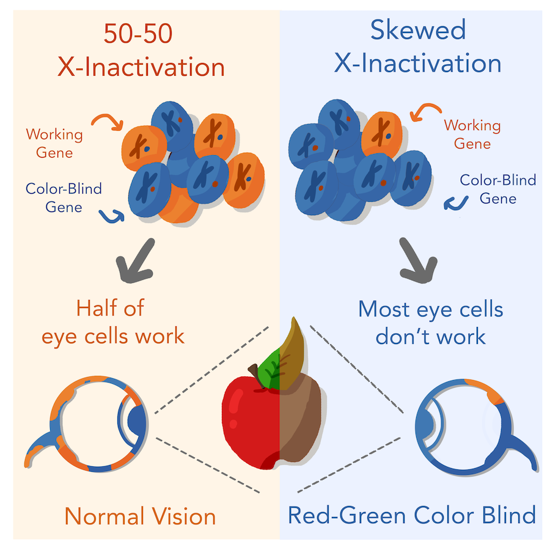
Could X-inactivation cause a heterozygous female carrier to be colour blind?
March 6, 2020

- Related Topics:
- Color vision deficiency,
- X inactivation,
- X linked inheritance,
- Carrier,
- Dominant and recessive
A High School bio student from India asks:
"I wanted to know how X inactivation and inheritance of X-linked recessive diseases in females are linked. For example, how do female carriers of colour blindness have normal vision?
Do all the X’s with colour blindness inactivate, making her normal? If so, isn’t that against the fact that X chromosomes randomly inactivate in each cell? And if the X chromosomes do randomly inactivate then there is a chance that 80% of eye cells working colour gene and 20% don’t? Then shouldn’t it be possible for a heterozygous female to be colour blind?"
In general, women who carry a color blindness mutation have normal color vision. And in general, X chromosome inactivation is random, so on average 50% of cells will inactivate one X chromosome and 50% will inactivate the other. Carriers of color blindness only have 50% of their “normal” X chromosomes activated, but this is still enough to be able to see in color.
But as with almost everything in biology, there are exceptions!
You have a great point. It is completely possible that, just by chance, more than 50% of cells could inactivate the same X chromosome. Even though the average is 50:50, there will always be examples that are slightly higher or lower.
And if that happens in a woman who is a carrier for an X-linked disease, she might have some symptoms. There are examples of this for several X-linked disorders—including color blindness.
But before we go into the details, let’s review what X inactivation is.
What is X chromosome inactivation?
In humans, the X and Y chromosomes mostly determine biological sex. People with one X and one Y chromosome generally develop as male (XY). People with two X chromosomes generally develop as female (XX).
But this poses a genetic problem! Half of all humans have a double dose of X chromosome. And normally, it’s bad to have extra chromosomes. So how are people fine with either 1 or 2 of them? How do you keep things balanced?
To solve this problem, humans (like many mammals) use something called X chromosome inactivation.
Very early on in development, when a female embryo is only around 8-16 cells in size, each cell “turns off” one of its X chromosomes1,2. Each individual cell randomly chooses an X chromosome to inactivate. So around 50% of cells in the body inactivate one X chromosome, while 50% of cells inactivate the other.

X-linked disorders
Just like on any other chromosome, genes on the X chromosome can sometimes be faulty. Conditions caused by these genes are called X-linked disorders.
Some common examples of X-linked disorders include: hemophilia, certain types of muscular dystrophy, fragile X syndrome, and red-green color blindness.
For many X-linked disorders, if a person has at least one working version of the gene they will not have the disease. That makes them recessive disorders.
This is why X-linked diseases are more likely to affect males. Males only have one X chromosome! If a gene on it has a mutation, they don’t have another healthy X chromosome to compensate.
In contrast, females have two X chromosomes. Both copies of the gene would need to be mutated for her to have the disease.
X Inactivation and color blindness
So where does X chromosome inactivation come into this? Let’s take the example of red-green color blindness.
Color blindness is caused by mutations in special proteins that absorb light, called opsins. You have several different genes to make these proteins, which help you see a full range of colors.
One of these color-vision genes is on the X chromosome. It happens to make a protein that helps you distinguish red and green. If you can’t make this protein, then you won’t be able to tell red light apart from green light—you’ll be color blind4.

So what if a person has two X chromosomes, and only one of them has a mutated opsin gene? (Otherwise known as a carrier.)
From what we’ve learned, 50% of their cells should inactivate the X chromosome with the working gene, and 50% should inactivate the X chromosome with the mutated gene. That means half of the cells in their eyes will be able to see color, and half will not.
It turns out that just half of your eye cells seeing color is good enough.
Most people with one working version of the gene plus one color blind version have normal color vision. But like I mentioned, there are exceptions to every rule!
Skewed X inactivation
X inactivation is random. It can happen that—just by chance—more than 50% of cells might inactivate the same X chromosome. This is called skewed X inactivation.
Exactly how X chromosome inactivation becomes skewed is not well understood. It probably usually happens just by chance! But it can also be caused by a mutation on one X chromosome that makes it more likely to be inactivated5–7.
Skewed X inactivation is hard to measure in humans, so we don’t have a lot of information about it. But some studies found that up to 25% of women could potentially have skewed X chromosome ratios, where at least 70% of cells inactivate the same chromosome.1,8 (There are even rare cases where more than 90% of cells inactivate the same chromosome!)
As you can imagine, skewed X inactivation can have a dramatic effect on people with X-linked disorders.
One way to study this effect is by studying identical twins who are carriers for an X-linked disorder (women who have one mutated gene and one working version). Since identical twins have identical DNA, you would expect them to have the same symptoms.
But in rare cases, one twin can have symptoms of an X-linked disorder, while the other does not!6,9,10 There are multiple examples of this happening in people with hemophilia, muscular dystrophy, and—yes—red-green color blindness.
How can one female twin have normal vision, while her identical twin is color blind? When scientists analyzed cells from both twins, they found that the cells from the color blind twin had mostly inactivated the X chromosome with the working gene11.

And even though I just told you that women who are carriers for color blindness mutations have normal vision… that’s only mostly true. On average, they tend to do slightly worse on color vision tests than people without these mutations12,13. It’s possible that even a minor skew in X chromosome inactivation causes slight differences in color vision14,15.
When we learn about genetics, we’re usually taught the basic rules: X chromosome inactivation is random, and a female carrier will not be not color blind. That’s mostly true!
But biology is always more complicated than we expect, and there are always exceptions to the rules. Asking questions like yours is a great way to learn things you probably wouldn’t learn otherwise!

Author: Ellen Bouchard
When this answer was published in 2020, Ellen was a Ph.D. candidate in the Department of Developmental Biology, studying the genetic and molecular basis of how the vertebrate nervous system develops in Will Talbot’s laboratory.
 Skip Navigation
Skip Navigation
